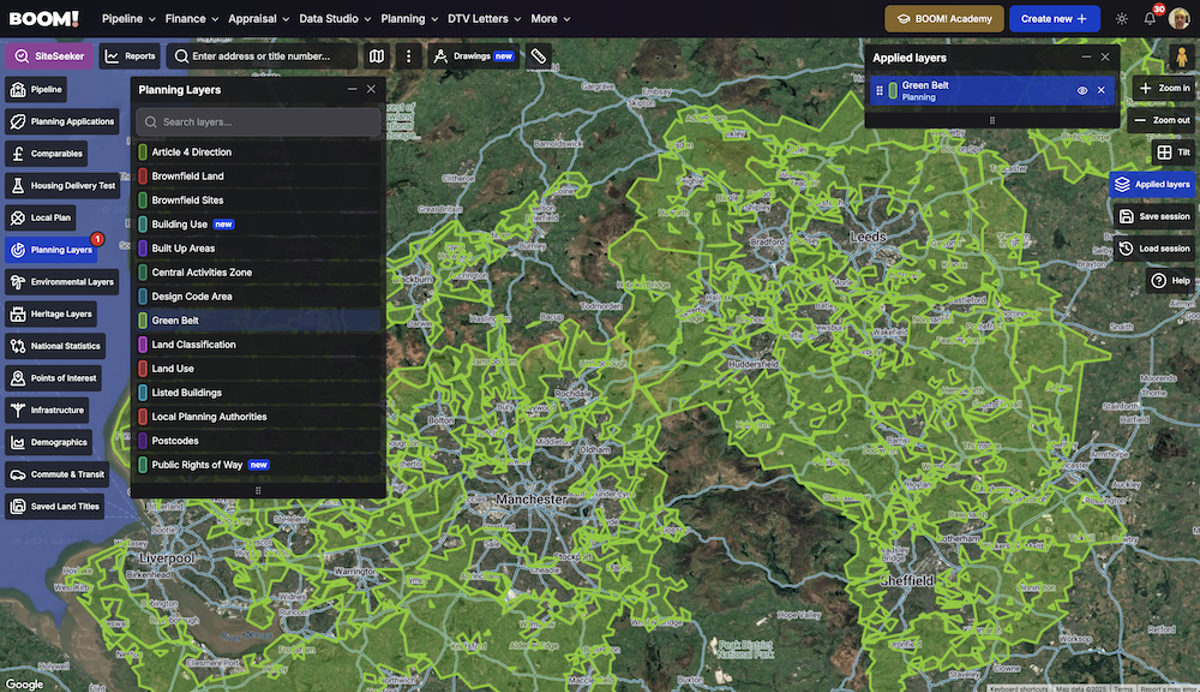Green Belt Unlocked: 4 Ways New UK Developers Can Build (Legally) in 2025







Green Belt land is famously off-limits – a frustrating hurdle for property development beginners. The UK’s Green Belt (over 12% of England ) exists to prevent urban sprawl by keeping land permanently open. In plain terms, building on Green Belt is extremely tough. Local authorities rarely approve development there “except in very special circumstances”. In fact, getting Green Belt planning permission is more difficult by design. But can you build on Green Belt at all? The answer: yes – if you know the exceptions. This guide reveals actionable Green Belt opportunities for new UK developers and land sourcers, from brownfield sites to a new 2025 “Grey Belt” policy that’s shifting the game.
Green Belt 101: What It Is and Why It Matters
The Green Belt is a ring of protected countryside around many cities, set up to curb reckless expansion. First established in the 1940s, it forces developers to look inward, promoting urban regeneration instead of endless sprawl. Green Belt land acts as the “countryside next door” for millions, safeguarding green space for recreation, farming, wildlife, and flood protection. Because of these benefits, the rules are strict: most new construction on Green Belt land is inappropriate and harmful, and will not be approved absent special justification. In short, Green Belt matters – and every UK property developer must respect its limits.
Key Restrictions: In practical terms, building on Green Belt is generally banned. If you see a “green belt land for development” listing, be cautious. Unless your proposal fits a narrow exception in policy, the default answer is “No, you can’t build on Green Belt.” The National Planning Policy Framework carves out only a few exceptions (e.g. certain community projects, infrastructure, or agricultural buildings). For small-scale developers, the most relevant exceptions boil down to using already-developed or low-impact sites. Below we cover four beginner-friendly strategies to work within the rules.
1. Brownfield Redevelopment – Prioritise Previously-Developed Sites
What: Brownfield vs Green Belt – when it comes to development, brownfield (previously developed land) is the low-hanging fruit. Even within Green Belts, previously developed (brownfield) sites can often be reused or redeveloped without undermining Green Belt purposes. Examples include disused airfields, old hospitals, derelict industrial yards, or scrap yards tucked away in the Green Belt.
Why: National policy promotes making “as much use as possible” of brownfield land before touching green fields. Redeveloping an eyesore brownfield plot can actually enhance the area without causing new sprawl. For instance, replacing an abandoned factory with housing inside a Green Belt can be acceptable if the new buildings don’t exceed the footprint or height of what’s already there. Councils give “substantial weight” to proposals that clean up derelict sites.
Action: As a new developer, hunt for brownfield land for development in or around Green Belt zones. Check your council’s Brownfield Land Register (required by law ) for sites earmarked as suitable for housing. If you find a previously-developed site, design your scheme to match or shrink the existing built volume so you maintain openness. A well-planned brownfield redevelopment stands a far better chance of approval than a build on pristine land.
2. Village Infill – Small Gaps, Big Potential
What: Many Green Belts include villages where some “limited infilling” is allowed. Limited infill in villages means building on a small gap between existing homes or within a built-up frontage. This is not a green light for big estates, but a single plot that fills in the village fabric may qualify.
Why: A tiny development within an existing village doesn’t sprawl into open countryside. National policy explicitly lists “limited infilling in villages” as an exception to Green Belt restrictions. Of course, “limited” is subjective – typically one or two homes on a modest gap. The key is that your project rounds off the village rather than extending it outward. For example, inserting a new house on a short empty plot between cottages might be seen as keeping with the village pattern, thus potentially acceptable.
Action: If you’re eyeing Green Belt villages, look for infill opportunities: perhaps a sizable gap in a row of houses or a vacant lot surrounded by development. Research the local plan and any defined village infill boundaries. Some councils map out which villages qualify for infill and what scale is considered “limited”. Pitch any project as small-scale and in keeping with neighboring homes. When done right, village infill can slip through the Green Belt restrictions by being practically invisible in the landscape.
3. Replacement Buildings – Out with the Old, In with the New
What: Another beginner-friendly route is replacement development. Green Belt rules allow you to demolish an existing building and replace it with a new one, as long as the new one isn’t significantly larger. In other words, if there’s a rundown house or structure on Green Belt land, you might get permission to build a new dwelling in its place.
Why: The logic is simple – you’re not introducing a brand-new footprint, just swapping one building for another. This can actually improve the site (think energy efficiency and design) without much greater impact on openness. Councils typically insist the replacement is “not materially larger” than the original (often interpreted as no more than ~30–40% bigger, though policies vary). For instance, replacing a dilapidated bungalow with a modern house of similar size could be seen as maintaining the status quo in Green Belt terms.
Action: Identify existing structures on Green Belt land – old bungalows, barns, or even commercial buildings – that could be legally replaced. Verify that the structure is permanent and has lawful use (e.g. a house that’s been there for years). When designing the new build, keep it comparable in scale to the old one. Highlight any benefits (better design, no increase in height, etc.). By positioning your project as a one-for-one swap, you greatly increase the odds of green belt planning permission approval for a new build.
4. Class Q Barn Conversions – Turning Farms into Homes
What: Did you know some agricultural buildings can be converted to homes without full planning permission? Class Q is a game-changing permitted development right that lets you transform a barn into up to five (now even ten) dwellings, subject to criteria. Crucially, Class Q applies in Green Belt areas too (with some exceptions for protected landscapes).
Why: Class Q is part of national permitted development rules – essentially a planning loophole intended to boost rural housing. If a barn qualifies (size, age, and location conditions apply), you only need to seek prior approval for certain impacts (like transport, noise, design), rather than a full planning application. In May 2024, rules expanded: now up to 10 homes can be created and up to 1,000 m² of floor space converted. This means even in Green Belt, you could convert a disused farm building into new homes quickly and legally.
Action: For property development beginners eyeing the countryside, Class Q is a golden ticket. Look for farm outbuildings or barns on the market. Check that the building meets Class Q conditions (e.g. it’s been in agricultural use and is structurally sound – not a ruin). If eligible, draft a conversion plan that stays within the floorspace and design limits. Since no green belt map UK will flag a permitted barn conversion as “inappropriate,” you can often secure consent in a matter of weeks under Class Q. It’s one of the fastest ways to create new homes on Green Belt land by reusing what’s already there.
Grey Belt: 2025’s Game-Changer for Green Belt Land
Until now, Green Belt rules treated all sites the same – a “hands off” policy regardless of a site’s individual merit. That changed with a new Grey Belt policy shift in late 2024/2025. The Government introduced “Grey Belt” as a subset of Green Belt in the updated planning framework. In simple terms, Grey Belt land = Green Belt sites that are previously developed or that don’t really serve the Green Belt’s core purposes. Think of scrappy, low environmental quality patches: e.g. a former petrol station, a scrubby yard by a motorway, or an enclave of buildings that isn’t scenic countryside.
Why it matters: For the first time in decades, there’s an explicit path to build on certain Green Belt sites if they meet Grey Belt criteria. To get approval on Grey Belt land, a project must still check several boxes – the development shouldn’t “fundamentally undermine” the remaining Green Belt, must meet a demonstrable need, and be in a sustainable location, among other tests. Housing is a big driver, but even commercial schemes can qualify. Councils are now encouraged to identify Grey Belt land when reviewing Green Belt boundaries. Early appeal decisions in 2025 show about one-third of housing proposals on Grey Belt land succeeding, a much higher hit rate than traditional Green Belt.
Action: New developers should watch for Grey Belt opportunities. In 2025, some councils will map or list Grey Belt sites (land that contributes weakly to Green Belt purposes). These spots could be ripe for development under the more lenient rules. If you find a marginal Green Belt plot (say a scruffy edge-of-town lot), examine whether it fits Grey Belt definitions – is it previously built on? Surrounded by development? Invisible in terms of countryside character? If so, you may have a case to build. This policy shift means green belt land for development isn’t a fantasy – certain sites are emerging as fair game.
(Pro tip: The official gov.uk guidance on Green Belt was updated in Feb 2025 with a section on assessing “grey belt” land. Use it to back up any Grey Belt planning arguments.)
Next Steps: Smarter Land Sourcing with BOOM!

Identifying these hidden opportunities – brownfield pockets, infill plots, replaceable buildings, or Grey Belt sites – can be like finding a needle in a haystack. This is where PropTech tools come in. Modern land sourcing platforms like BOOM! exposes data to pinpoint high-potential land. For example, BOOM’s tech can filter for off-market sites by criteria – you can literally target “grey belt” or “roadside” plots using its SiteSeeker tool. These platforms pull together planning data, ownership info, and environmental constraints to save you weeks of research.
To better understand how you can leverage Green Belt sign up for a 7 day FREE trial or book a call with us and let us show you. We also offer a free tool which helps you understand whether a postcode is affected by Green Belt.